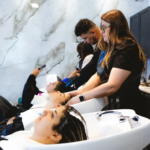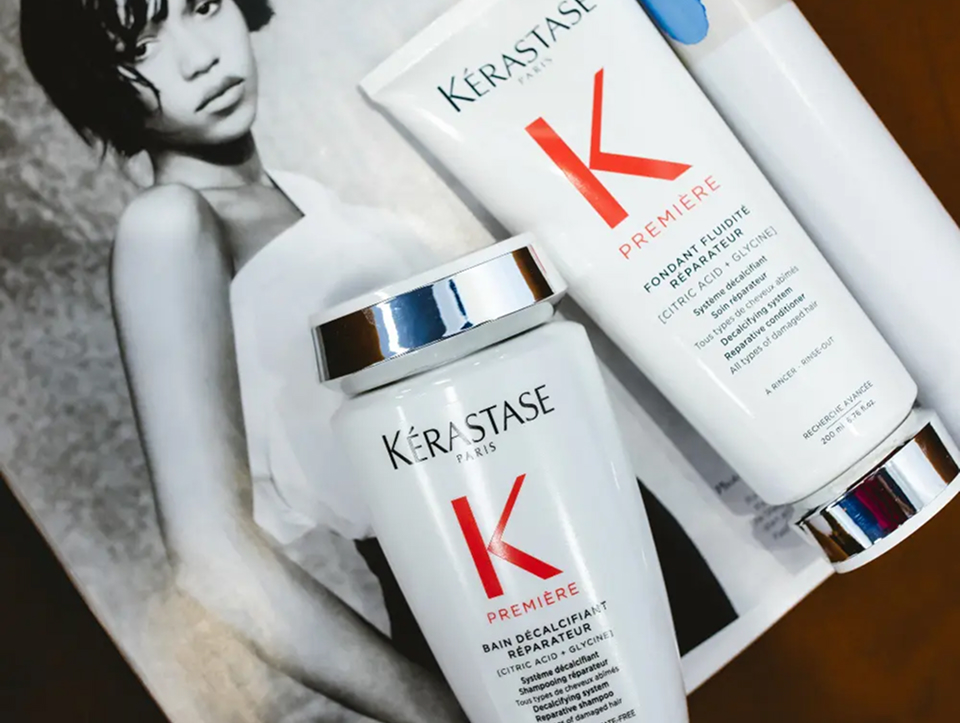Split ends are more than just a cosmetic nuisance — they’re a sign your hair is crying out for help. You may notice brittle, dry strands that tangle easily, no matter how much conditioner you use.
These frayed ends occur when the outer layer of your hair breaks down due to heat, chemical processing, or friction, leaving the strand vulnerable to splitting.
At Häste Hair in Medford, we specialize in advanced split end repair treatments that smooth, strengthen, and restore your hair’s health.
In this guide, we’ll explain what causes split ends, how to fix them, and what you can do today to stop them from coming back.
What Are Split Ends And Why Do They Happen?
Split ends occur when the protective outer cuticle of your hair shaft wears away, exposing the fragile inner layers. This causes the hair strand to split — usually at the tip, but sometimes even higher up along the shaft.
Why does this happen? There are several common culprits:
- Improper Hair Care: Not treating your hair gently during brushing or using harsh shampoos can damage it, leading to split ends.
- Chemical Treatments: Bleaching, perming, or dyeing your hair exposes it to strong chemicals, leading to split ends.
- Styling With Heat: Using tools like curling irons and hair straighteners can cause hair to dry out and become fragile, leading to split ends and breakage. To prevent this, consider our guide on how to blow-dry your hair without damaging it.
Your hair is like a plant that withers with heat, rough treatment, and chemicals, leading to protein loss. Infrequent hair trims are another cause of split ends. Furthermore, you also get different types of split ends.
Types of Split Ends (And What They Mean)
Not all split ends look or behave the same. Here’s what to watch for:
- Single Split – A simple Y-shape, often from UV or heat damage.
- Feather Split – Multiple strands branching out, usually from overbrushing or heat abuse.
- Fork Split – Two uneven splits from harsh handling or friction (think: wool scarves).
- Tree Split – Multiple small offshoots, a sign of severe dryness or structural weakness.
- Incomplete Split – A crack in the strand that hasn’t fully separated — a warning sign of what’s coming.
Each type may require a slightly different approach to split end repair, which our stylists can assess during your treatment at Häste Hair.
5 Best Ways to Repair and Prevent Split Ends
1. Trim Every 6 To 8 Weeks

It sounds obvious, but it’s the most effective fix. A professional trim removes damage before it travels up the strand, reducing further breakage. Think of it as resetting your ends for a fresh, healthy start.
✂️ Book a quick refresh cut at Häste Hair and give your strands new life.
2. Deep Conditioning Regularly

Deep conditioning treatments saturate your hair with moisture, helping to repair split ends by restoring flexibility and shine. We use nutrient-rich masks that seal the cuticle and strengthen the strand from within.
💧 Try our customized deep conditioning at Häste — results visible after just one session.
3. Use Heat Protectant Every Time

If you style with heat, this is non-negotiable. Apply a thermal protectant before blow-drying or flat-ironing to create a barrier between your hair and damaging temperatures. Over time, this can significantly reduce the formation of new split ends.
💨 Want a sleek look without damage? Book a professional blowout that prioritizes hair health.
4. Protect Hair From External Stress

UV rays, pollution, and even your pillowcase can weaken the hair shaft. Wear protective styles (buns, braids, silk wraps), sleep on satin or silk pillowcases, and avoid rough brushing while your hair is wet.
🌿 Consider a scalp therapy treatment in-salon to strengthen follicles and nourish from the root.
5. Add a Protein Treatment to Your Routine
Hair is made of keratin, a protein that breaks down when your hair is exposed to stress. Replenish it with salon-grade protein masks that help rebuild structure and elasticity.
🧬 Ask us about our Kerastase or custom-blended protein treatments for split end repair.
Split End Prevention Tips You Can Start Today

Taking care of your hair can help prevent split ends. Here are some steps to consider to keep your hair healthy without split ends:
- Handle your hair with care and kindness. Instead of yanking it, use a wide-toothed comb to detangle it. Avoid aggressive brushing when your hair is wet, as it is very fragile.
- The hair tools you find available, from brushes to combs, are not equally created. Invest in high-quality brushes with smooth, non-pulling bristles.
- Sleeping on silk or satin pillowcases is best, as these materials cause less friction on your hair.
- Wash your hair using sulfate-free shampoos, as they are gentler. Wash your hair with cool water instead of hot water, as hot water can strip your hair of its natural oils, leaving it brittle. After you wash your hair, gently pat it dry with a soft towel.
- Additionally, consume a balanced diet rich in minerals, proteins, and vitamins to support healthy hair growth.
Being mindful of how you treat your hair is essential, as it helps prevent split ends. Most importantly, long-term prevention is about using the right products and maintaining your body’s hydration with water.
Also, try to manage your stress where possible. Stress can cause your hair follicles to enter a rest phase known as telogen, which prevents the production of new hair strands. You may end up shedding hair, which can lead to thinning of your strands.
Lastly, get enough exercise as it keeps you fit and contributes to healthy hair.
Myths Related to Split-End Repair
Split ends are common in everyone, and there is loads of advice on how to deal with them. However, not all the advice you receive is accurate, and we are here to help you clarify it.
You Can Repair Split Ends Without Cutting Them
This is not entirely true, as there is no magical remedy for repairing split ends. The best way to treat split ends is with regular trims, which help prevent the split from traversing up the hair shaft.
Using Special Shampoos Can Repair Split Ends
While some shampoos can help repair split ends, they do not reverse the damage. It can temporarily seal those ends, leaving an illusion of a repair, but it will resurface.
You Can Fix Split Ends By Oiling Your Hair
Oils can add moisture and shine to your hair, but they will not repair your split ends. They will temporarily hide your frayed ends, but do not address the problem.
Doing More Conditioning Prevents Split Ends
Using an excessive amount of conditioner will not prevent split ends. Using the correct conditioner that focuses on proper hair care would be best.
When You Repair Split Ends, Your Hair Grows Faster
Repairing split ends does not accelerate hair growth. However, trimming them with a professional haircut helps prevent breakage and makes the hair healthier.
Can Split Ends Be Treated
Yes — but only with consistent, intentional care. Split end repair isn’t about one miracle product. It’s about understanding the root causes of damage, using the right treatments, and committing to better hair habits.
At Häste Hair, we offer more than just trims. We offer targeted treatments, science-backed products, and expert styling that protects your hair’s integrity from root to tip.
💡 Ready to ditch the damage? Book a split end repair treatment with us today and discover how beautiful healthy ends can be.
FAQ
What are split ends?
Split ends occur when the outer layer of the hair shaft becomes damaged, causing the hair to fray and split.
Can split ends be fixed without cutting?
Temporarily masked, yes — but proper repair requires trimming off the damaged portion.
Are some hair types more prone to split ends?
Yes. Fine, curly, and chemically treated hair is often more susceptible to splitting.
Do oils help with split ends?
They don’t heal splits but can improve shine and reduce friction, preventing further breakage.
What’s the best salon treatment for split ends?
A combination of trimming, deep conditioning, and protein-based strengthening treatments yields the best results.









